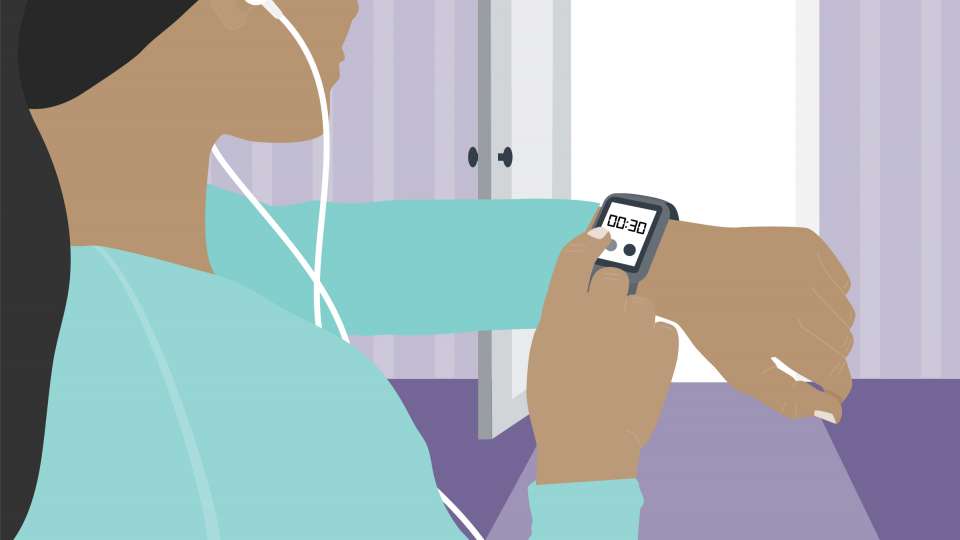
Choosing what workout to do from day to day can feel like picking from an overwhelming menu: a 30-minute barre workout, an hourlong YouTube yoga class, a 45-minute walk, a 10-minute core routine … the list goes on.
As you consider your options, you may wonder: How long should you work out? And what kind of exercise should you do?
While there’s no one-size-fits-all answer to how often you should exercise, there are helpful guidelines that can shape your weekly workout schedule.
Dr. Cindy Lin, clinical associate professor of rehabilitation medicine at UW Medicine and associate director of clinical innovation for The Sports Institute at UW Medicine, discusses the recommended number of active minutes per week and explains how you can portion those minutes into approachable, effective workouts that benefit your health.
How often should you work out each week?
You may have heard something about working out for at least 150 minutes a week. But what does that look like in practice?
“According to the U.S. National Physical Activity Guidelines, adults should aim for at least 150 minutes of moderate-intensity aerobic activity, such as brisk walking, each week,” says Lin. “In addition, at least two days a week of activities that strengthen muscles are also recommended.”
While 150 minutes might sound like a long time to sweat, it’s meant to be broken up in a way that works with your lifestyle and fitness baseline.
“Each workout session can have a different length of time and many combinations of activities meet the guidelines,” says Lin. “The guidance provides a general plan that can be flexible to fit different people’s daily schedule.”
For instance, you could go for a brisk walk 30 minutes a day, five days a week. Or if vigorous-intensity aerobic activity such as high-intensity interval training (HIIT) or a sweaty spin workout is more your jam, the guidelines indicate that 75 minutes of that intensity of activity also counts.
And if you’re wondering whether your exercise of choice falls into the moderate- or vigorous-intensity bucket, Lin explains how the “talk test” can help you to tell the difference.
“As a rule of thumb, a person doing moderate-intensity aerobic activity can talk but not sing or carry on a tune during the activity without needing to pause for a breath. A person doing vigorous-intensity activity cannot say more than a few words at a time without pausing for a breath,” says Lin.
In either scenario, there are added health benefits to also doing muscle-strengthening activities on two or more days a week that work all major muscle groups (your legs, hips, back, abdomen, chest, shoulders and arms).
Make your workout schedule work for you
If you don’t regularly work out, don’t sweat it if you don’t reach 150 minutes of exercise per week. (In fact, 80% of American adults do not meet the U.S. physical activity guidelines for aerobic and muscle strengthening activities.)
“For individuals who are not exercising regularly currently, it’s absolutely OK to start at short bouts of activity such as 10 minutes at a time,” says Lin.
Squeezing in spurts of activity throughout the day is called “fitness snacking.”
“Fitness snacking means to perform several shorter bouts of activity spread throughout the day,” explains Lin. “Fitness snacking is a great way to incorporate physical activity into your day if you don’t have time to perform a full workout. A little activity is better than none and you still reap health benefits from these short bursts.”
So, if you’re crunched for time, you could replace your 10-minute break between Zoom meetings with short activities like taking the stairs or doing yard work. Before you know it, you’ll have checked your items off your to-do list and reached your workout goals.
Is there an ideal length of time for each workout?
While there’s no one-size-fits-all answer to this question, a good starting place is to look at your current exercise schedule and identify how often and long you exercise.
This can help you determine your baseline fitness, which the U.S. National Physical Activity Guidelines suggests using as a guide for how often and long you should exercise.
As a general guideline, the Centers for Disease Control and Prevention recommends exercising 30 minutes a day, five days a week.
For those who don’t exercise regularly, the U.S. National Physical Activity Guidelines suggests adding a small and comfortable amount of light- to moderate-intensity activity into your routine, such as walking for five to 15 minutes, two to three times a week.
Regardless of your fitness level, Lin recommends spreading out your workouts throughout the week, if possible.
That’s because squeezing a week’s worth of exercise into one long sweaty session can put your body and joints under stress, which can lead to overworked muscles and ligaments or injuries.
Why you should also take rest days
Another effective way to reduce the risk of injury is to take rest days.
So, don’t feel guilty for not getting your sweat on every day of the week. Giving your body time off to recover serves a purpose, too.
How do you determine if you need a rest day?
“The number of rest days needed in a given week all depends on the intensity of your physical activity,” explains Lin. “Lower intensity requires less rest days. If you’re unsure whether you need a rest day, it’s okay to start a workout lightly to gauge how you feel. If you’re feeling muscle soreness or joint pain, cut back on the higher intensity activity until it subsides.”
On rest days, you can focus on other aspects of your well-being that can help your body recover after a workout.
“Stretching, muscle tension release, meditation, good sleep, nutrition and hydration are all great ways for our muscles to rest and restore,” says Lin.
Following those tips will help you recover so that you can bring your best to your next workout.
And remember: If your workout plans get delayed or cut short, give yourself some grace and keep in mind that any activity you do — from chasing your kids to mowing the lawn — has health benefits.
Before starting a new exercise routine, it's a good idea to talk to your doctor — especially if you have any health conditions or are recovering from COVID-19.

 Healthy ideas for your inbox
Healthy ideas for your inbox





